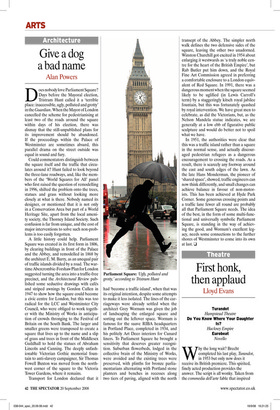Give a dog a bad name
Alan Powers
Does nobody love Parliament Square? Days before the Mayoral election, Tristram Hunt called it a ‘terrible place: inaccessible, ugly, polluted and grotty’ in the Guardian. When the Mayor of London cancelled the scheme for pedestrianising at least two of the roads around the square within days of his election, there was dismay that the still-unpublished plans for its improvement should be abandoned. If the proceedings within the Palace of Westminster are sometimes absurd, this parallel drama on the street outside was equal in sound and fury.
Could commentators distinguish between the square itself and the traffic that circulates around it? Hunt failed to look beyond the three-lane roadways, and, like the members of the ‘World Squares for All’ panel who first raised the question of remodelling in 1996, shifted the problem onto the trees, statues and grass without looking more closely at what is there. Nobody named its designer, or mentioned that it is not only in a Conservation Area but part of a World Heritage Site, apart from the local amenity society, the Thorney Island Society. Such confusion is far from unique, and the cost of major interventions to solve such non-problems is too easily forgotten.
A little history could help. Parliament Square was created in its first form in 1806, by clearing buildings in front of the Palace and the Abbey, and remodelled in 1868 by the architect E. M. Barry, as an unequal pair of traffic islands divided by a road. The wartime Abercrombie-Forshaw Plan for London suggested turning the area into a traffic-free precinct, and the Architectural Review published some seductive drawings with cafés and striped awnings by Gordon Cullen in 1947 to show how the square could become a civic centre for London, but this was too radical for the LCC and Westminster City Council, who were obliged to work together with the Ministry of Works in anticipation of crowds thronging to the Festival of Britain on the South Bank. The larger and smaller greens were transposed to create a square that lives up to the name and a slip of grass and trees in front of the Middlesex Guildhall to hold the statues of Abraham Lincoln and Canning. The deeply unfashionable Victorian Gothic memorial fountain to anti-slavery campaigner, Sir Thomas Fowell Buxton was moved from the northwest corner of the square to the Victoria Tower Gardens, where it remains.
Transport for London declared that it had ‘become a traffic island’, when that was its original intention, despite some attempts to make it less isolated. The lines of the carriageways were already settled when the architect Grey Wornum was given the job of landscaping the enlarged square and sorting out the leftover space. Wornum is famous for the suave RIBA headquarters in Portland Place, completed in 1934, and his politely Art Deco interiors for Cunard liners. To Parliament Square he brought a sensitivity that deserves greater recognition. Suburban flowerbeds, lodged in the collective brain of the Ministry of Works, were avoided and the existing trees were preserved, with plinths for bronze parliamentarians alternating with Portland stone planters and benches in recesses along two tiers of paving, aligned with the north transept of the Abbey. The simpler north walk defines the two defensive sides of the square, leaving the other two unadorned. Winston Churchill got excited in 1954 about enlarging it westwards as ‘a truly noble centre for the heart of the British Empire’, but Rab Butler put him down, and the Royal Fine Art Commission agreed in preferring a comfortable enclosure to a London equivalent of Red Square. In 1991, there was a dangerous moment when the square seemed likely to be uglified (in Lewis Carroll’s term) by a staggeringly kitsch royal jubilee fountain, but this was fortunately quashed by royal intervention. We have great men to celebrate, as did the Victorians, but, as the Nelson Mandela statue indicates, we are generally at a low ebb of figurative public sculpture and would do better not to spoil what we have.
In 1951, the authorities were clear that this was a traffic island rather than a square in the normal sense, and actually discouraged pedestrian refugees as a dangerous encouragement to crossing the roads. As a result, there is scarcely any footway around the east and south edges of the lawn. As the late Hans Monderman, the pioneer of ‘shared space’, showed, traffic engineers can now think differently, and small changes can achieve balance in favour of non-motorists. This has been achieved at Hyde Park Corner. Some generous crossing points and a traffic lane fewer all round are probably all that Parliament Square needs. The idea of the best, in the form of some multi-functional and universally symbolic Parliament Square, is standing in the way of achieving the good, and Wornum’s excellent legacy, needs some connections to the further shores of Westminster to come into its own at last. ❑










































































 Previous page
Previous page